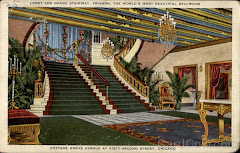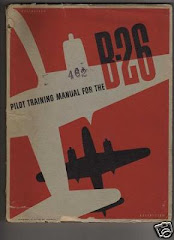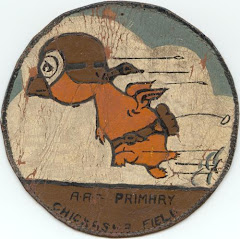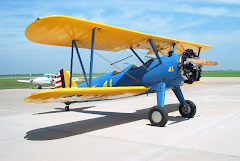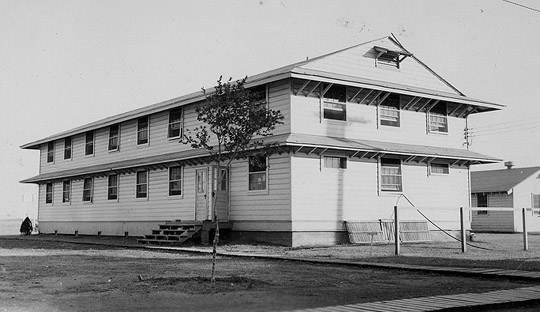Today we take time to remember, honor and thank all the brave veterans of all the wars who fought to protect our freedoms.
On this 11th day of the 11th month at 11:11 stop for just a minute and imagine you can hear the 21 gun salute and the playing of TAPS to honor and keep the faith with all our soldiers.
We can never thank them enough.
Wednesday, November 10, 2010
Saturday, November 6, 2010
Chapter 25 - Off We Go Into the Wild Blue Yonder!
The targets included marshalling yards, roads, bridges, ammunition dumps, power stations and shipyards. We flew in formation in what they called boxes. The mission leader flew in the middle of the first row with #2 plane on his right and #3 plane on his left. Directly behind the leader was #4 with #6 on his right side and #5 on his left side.
Usually the leader was the only plane with what they called the Nordin Bomb Site. That was a special navigation instrument for locating your exact target. They weren’t very plentiful at the time and every plane in the formation was to watch the leader – when he dropped his bombs you dropped yours. If no one had a Nordin, everything was done by sight navigation.
B-26 In Flight
B-26s in Formation, Flak Exploding
We flew seven missions in March and twelve missions in April. On non-mission days we were doing a lot of training now that we understood what combat was. The crew always wore parachutes in case we were hit and had to abandon the ship. Medium level (altitude) bombing meant we were flying in the range of 8,000 to 10,000 ft. At 10,000 feet you had to wear your oxygen mask. It got pretty cold at those altitudes. We were dressed in uniforms with electric wires that we could plug in to get warm.
The biggest hazard was the anti-aircraft (ack-ack) guns being shot at us from the ground. We were doing daylight bombing and you could see it exploding all around you plus it created wind bumps every time it was close. Eventually there were diversionary tactics that we took at higher altitudes. The whole formation had to follow the same orders. Trying to divert to avoid ack-ack on our own would put the formation at risk of colliding with each other so there was no dodging bursts on your own. It made for raw nerves most of the time. The second hazard was actual attack by the Luftwaffe. That’s when our fighter planes (mostly RAF Spitfires) were supposed to protect us. So far we’d managed to escape both the ack-ack and the attacks with very little damage. We were also doing a fairly good job of hitting our targets.
One of our missions was called a “Grudge Raid.” You remember that the original B-26 low-level flying over Holland Netherlands France Holland was occupied by Germany but the people of Holland Holland
The Grudge Raid was targeting the same installations but this time we would be flying at 12,000 feet. That was our best altitude because by then they had found out it took the Germans seventeen seconds to track us and get a shell up to us at that altitude. Therefore, we never flew in a straight line for more than 15 seconds. Many times we could see big black clouds of exploding shells right where we would have been had we flown straight for another two seconds. I called that cutting it close. There were 300 B-26s on this Grudge Raid on the U-Boat installation.
The first week in May the 322nd threw quite a celebration when one of the B-26 planes, named the “Mild and Bitter” became the first bomber of the Allies to complete100 missions. Not only that, it had never lost an engine or sustained major damage and no crewman had ever been hurt on those missions. We weren’t assigned the same plane every time we flew, so over 166 men on the base had flown a mission on the Mild and Bitter at one time or other. It was the pride of the 9th Army and it was a big celebration. By the end of July there were a total of 10 B-26s in the 322nd that made it to 100 missions, a real tribute to their dependability. (After the disastrous start in Holland
About that time Command decided that we would do some night time training in formation flying. Our crew Captain, Lt. Davison decided that it was too dangerous to fly formation at night. He went to the Squadron Commander and told him he wouldn’t do it. The Commanding Officer called me in and told me what Davison said. He asked me what I thought about night flying. I said I thought it couldn’t be much more dangerous than flying over enemy territory in broad daylight and having anti-aircraft shells exploding all around us. He demoted Lt. Davison to co-pilot and made me crew commander. He assigned the same crew to me and gave me a new co-pilot by the name of Jimmie Deloach. Lt. Davison would be flying co-pilot with the C.O. from then on. It turned out we practiced some night flying but we never did actually fly any night time missions while I was there.
We flew another twelve missions in May. Most of them were on railroad yards and fuel dumps near cities along the coast of France
Thursday, October 28, 2010
Chapter 24 - We Finally Join the War!
Andrews Air Field, (Great Saling) Britain 1944
We were sent to Andrews Field which was located near Braintree , England London in the County of Essex Bury St. Edmonds Bury St. Edmonds Holland
Andrews was what they called a Class A airfield and was built by Americans about 18 months before we got there. Class A meant there were 3 runways, roughly located in a triangle shape. The main runway was 6,300 feet long, 300’ longer than usual. The other two runways were shorter. Andrews was the only British field named after an American: General Frank Maxwell Andrews, who had been killed in an airplane crash. Before that it was called Great Saling.
This base was the squadron headquarters and was a full operating base, not a training base. In addition to the headquarters, there was an iron hut building for mission briefings and debriefings, a mess hall, hospital, a chapel, store, supply warehouses, a motor pool and living quarters. The officer’s living quarters were on the east side and were mostly the corrugated iron huts with brick ends that had a door and 2 windows covered with black out curtains. The floors were concrete and there was a small stove in the middle for heat. They were cold, damp and musty. There was a bath hut with tubs, showers and hot water but little heat. Since our quarters were about a mile away from the runways we would mostly march from place to place. Bombs and ammunition were stored outside the perimeter in what they called munition “dumps.” They were a combination of concrete and dirt mounds to protect the ammunition from attack or crash landings. The fuel dump was on the north side of the base. There was a tower, two hangers and several maintenance shops for the constant repair of the planes coming back from combat. I think there were a couple thousand men on the base in one capacity or another.
On Mission days we were usually up at 5am and went to the mess hall for breakfast. Later, an Army truck would pick us up at quarters and deliver us to the briefing hut. Everyone was to be in the hut by a certain time and sometimes bring your equipment, other times get it afterward. That would include your full flight suit, flack jacket, warm helmet and hard helmet, gloves, parachute and combat gear. You didn’t want to put that on until you were ready to fly.
There was a stage at the front of the building (opposite the end with the door) and rows of chairs with an aisle down the middle. Behind the stage on the wall there was a map that was usually covered until the briefing started. Briefings started when the C.O. (Commanding Officer) walked into the building and someone yelled Attention! He would put us at ease and the Operations Officer would take over, reveal the map and give us the skivvy on the mission’s goals. It might be taking out an ammo dump, hitting a marshalling yard or whatever the target was. They would give us information about the target and tell us where we might encounter heavy anti-aircraft attack concentrations. We were given a lot of details, including things like the ships that we might pass over as we crossed the channel.
Crew pilots were given a Mission sheet which told them things like which plane their crew would be assigned to (by serial number) what place they’d be in the formation, what number they’d be in line for take off and what time they should start their taxi and take off. It told the Capt if there were other Groups on the Mission Mission day.
When I made Captain and got my first Mission sheet I was surprised to see the "Standard Operating Procedure to follow when landing on the Continent" clearly written out at the bottom. That would be equivalent to a crash landing – or at least a crippled emergency landing. The SOP said: 1. Whenever possible, land at a field at which 8th AF Service Command Center facilities are located. 2. Have radio operator contact base giving necessary information. Pilot can contact ground station on VHF. 3. After landing, pilot will (s) arrange for medial assistance, if necessary, (b) fill out “Forced Landing Card” from rear of pilot’s or co-pilot’s seat, (c) safeguard all secret and confidential items on ship, (d) contact nearest 8th AF Service Command Service Center representative if one isn’t on the field and (e) contact home base. (Use VHF or W/T in the air or on the ground.) 4. Crew members will be responsible for individual flying equipment.
After the main briefing, the Intelligence Officer filled us in and after that the weather reports. Then we’d set our watches so that everyone had the exact same time down to the second, so that we could follow the take off instructions exactly. Precision was extremely important. When the briefing was done and the C.O. marched out, we’d gather our gear or head back to get it and climb aboard the Army trucks that would take us all to our planes. Usually Officers went in one truck and enlisted men in another since we lived in separate huts.
Friday, October 22, 2010
Chapter 23 - Northern Ireland
Our assignment at Langford Lodge (the name of a Royal Air Force Base, not actually what we call a lodge) was what they called a replacement pool for the American groups in England Belfast Belfast

One thing that broke the monotony was kind of funny. We all looked forward to mail call and like everyone else I was always anxious to hear from my fiancé or my family. One day an envelope showed up – from the Man on The Street reporter in Jacksonville Avon Park
On the whole, time dragged on so much that some of the crews volunteered to transfer and get checked out in B-17s just to get out of
One day our crew was assigned a training flight. All B-26s were being retrained in medium altitude bombing. Lt. Davison, the Captain, was interested in reading a book, so he told me to take the flight up with the flight engineer in the co-pilot’s seat. He sat in the bomb bay and read his book. Just as we took off and were leaving the ground both props went into flat pitch! It was happening again! Only this time it was both engines at once and I was in the left seat! The engineer and I both pushed the manual overrides while I tried to keep the plane in the air. You had to be pretty strong to control these planes and again we were going down fast! At the same time I was trying to slow down our descent I doing everything I could to keep us going in a straight direction and restart the engines. Just as we managed to get the props going again and start gaining some altitude we broke through a power line that was located just past the runway area!
The Tower said all they could see was a big flash and they thought we blew up. Somehow it didn’t spark the fuel or electrocute any of us and when the flash cleared they saw the “phoenix” rising into the blue. I made a large turn and got back in line for landing. It was good to have our feet on the ground! When we examined the plane we found a large hole burned into one of the props where we’d hit the power line. The locals weren’t too fond of us after that. I think it took a couple days for them to get their power back.
Sunday, October 3, 2010
Chapter 22 – Assignment: Northern Ireland – Replacement Depot
After a week of getting to know each other’s families and getting to know each other better, it was time for me to get on a train back to camp. I sure hated to leave my family and my fiancé. When we got to Jacksonville , FL Jacksonville and I was looking for a phone to call Lorraine Avon Park
On August 25, 1943 we received our orders to proceed to Camp Kilmer , New Jersey Brooklyn , New York Camp Kilmer where, surprise!, we were to prepare to “set sail” for England Europe ! We were going to be the first group that wasn’t flying their own planes over. Apparently they had more planes than crews overseas. It would be another great experience: crossing the Atlantic by ship. Instead of getting into action in a couple days it was going to be a long trip.
After four days of hanging around Kilmer we were finally put on a train for a short trip to the Harbor where we boarded our ship – which turned out to be a converted cattle boat! We were part of a huge convoy of ships and escorts. About one day out of port our “ship” had trouble with one of its boilers. We had to leave the convoy and return to Brooklyn for repairs. For two or three days they worked on the old tub and we had to stay on board the whole time. There were over 2,000 people on board. Once the trouble was repaired we joined another convoy heading to England Atlantic , a sitting duck for German U-boats. Altogether we spent twenty-three days on the ship before we docked in Liverpool , England Prestwick AB , Scotland , then another boat to Belfast , Ireland Belfast
Tower at Langford Lodge 50 Years Later
Saturday, October 2, 2010
Chapter 21 - Rumors, Leave & An Engagement!
In mid-August the Army decided that we were definitely shipping out, so they gave us a 10 day leave to day good-bye to our families. Some of the guys in our group hadn’t had a leave in over a year. I’d been extremely lucky. I’d had 3 leaves in as many months. Lorraine
My mom and dad, back in Nebraska , decided they would come out to see me before I shipped out and they got on a train headed for Chicago Terre Haute my brother, his wife and Lorraine picked me up and we headed for Chicago Chicago
We checked into the Palmer House which was in the middle of what they called the Loop . I was told it was the most famous hotel in the city. I was sure it was actually a palace. All of us were in awe of the beautiful, huge lobby and its extravagant furnishings. The Palmer House was famous for its night club, the Empire Room, but my sister-in-law had her heart set on going to the Trianon Ballroom to dance to the music of Lawrence Welk. The Trianon was said to be the largest and most beautiful ballroom in the Country. It was so huge there was no problem getting in on short notice. I’d never seen or imagined anything like it. There must have been a thousand couples there that night but there was plenty of room to dance and you could hear the music from any part of the large dance floor.
I have to hand it to my sister-in-law, she had set the most romantic evening I could ever have imagined. “The Champagne Music Makers” played for hours and their music set the stage for romance. I’d given it a lot of thought and I new I was going to ask Lorraine Lorraine
Friday, September 24, 2010
Chapter 20 - We Ditch in the Swamp
When I got back to the Avon Park
The military has a way of yanking you back to attention. We went right back to calisthenics, marching to the mess hall, maintaining our quarters, attending classes and practicing flying techniques. Mostly that meant takeoffs and landings, which were never really monotonous for the pilots but the crew probably tired of them. There were also days when we did bombing target practice with no ammunition and eventually with live bombs.
We’d been assigned to flight crews of six. I was the co-pilot. One day when we were practicing take offs and landings we had a close call not too different from my first training flight with the Squadron Commander. Right after we were airborn and the landing gear was retracted, one engine went into flat pitch and quit! This was a 2-engine bomber! It was pretty hard to fly without one engine. We were past the end of the runway and over the swamp. All the power was coming from the other engine and it took everything we had to keep it from flipping over - at the same time we were going down fast. Things were happening very quickly.
Lt. Davidson, the Captain, alerted the tower we had an emergency landing and somehow managed to slide us into the swamp on the plane’s belly without doing much damage. Ambulances and fire trucks arrived. No one was hurt but we had to wade through the swamp to get back to the runway. I kept thinking of those water moccasins I’d seen and couldn’t get out of there fast enough for my comfort. We were lucky there was no live ammunition in the swamp.
The ambulance was waiting and took us back into camp to make sure we weren’t injured. They had to pull the plane out of the swamp, so later that day we got another plane and went on with training maneuvers - more take offs and landings. That was kind of ruff after the heart stopping event earlier. On the plus side, all the repetitive training, drills and memorization that the military drilled into us stood us in good stead in emergencies. You knew what to do.You reacted almost without thinking. I believe that belly whopper went on record as a crash landing even though they recouped the plane. It was another lesson that would pay off in my future. It gave us all something to write home about that night. And I was writing to "my gal" almost every night since I got back.
Subscribe to:
Posts (Atom)











